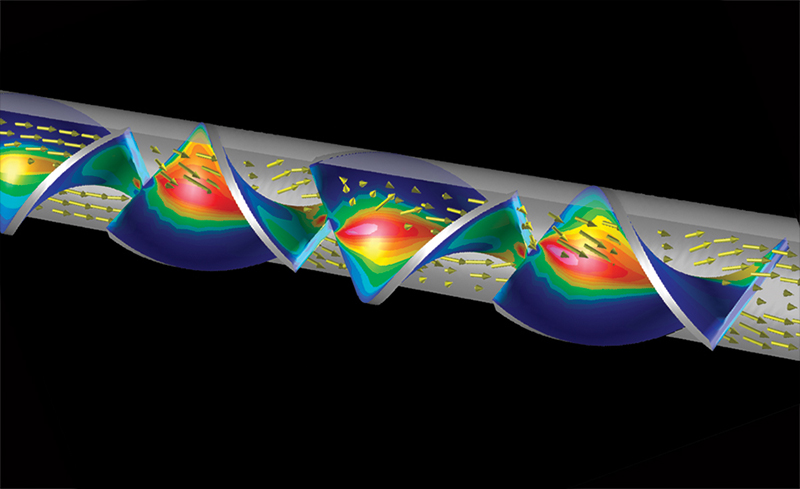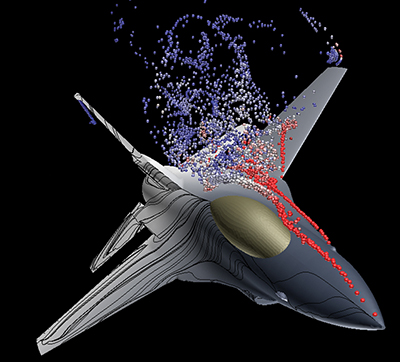
Free-Flowing Solutions for CFD
Licensed to over 1,500 customers worldwide, an advanced computational fluid dynamics (CFD) post-processor with a quick learning curve is consistently providing engineering solutions, with just the right balance of visual insight and hard data.
FIELDVIEW is the premier product of JMSI, Inc., d.b.a. Intelligent Light, a woman-owned, small business founded in 1994 and located in Lyndhurst, New Jersey. In the early 1990s, Intelligent Light entered into a joint development contract with a research-based company to commercialize the post-processing FIELDVIEW code. As Intelligent Light established itself, it purchased the exclusive rights to the code, and structured its business solely around the software technology. As a result, it is enjoying profits and growing at a rate of 25 to 30 percent per year.
Advancements made from the earliest commercial launch of FIELDVIEW, all the way up to the recently released versions 8 and 8.2 of the program, have been backed by research collaboration with NASA's Langley Research Center, where some of the worlds most progressive work in transient (also known as time-varying) CFD takes place. In 1994, Intelligent Light was contracted by Langley to develop tools for a special case of aero-acoustic post-processing. The company successfully delivered a modified version of FIELDVIEW to a NASA contracting branch that performs numerical integration of scalar functions over surfaces that are "swept" through time.
The following year, Langley awarded Intelligent Light a Small Business Innovation Research (SBIR) contract for advanced research into visualization technology. The SBIR focused on developing sophisticated transient data-handling capabilities to be integrated into the FIELDVIEW product. According to one Langley researcher who provided the data set during Phase I of the contract, the prototype demonstrated "an enabling technology that gives NASA a unique, affordable solution to a very difficult post-processing problem." The Phase II follow-on effort expanded the scope of the new data access and visualization technologies to unstructured and hybrid grids, as well as analyses that combine fluid/structure interaction. The research and development resulting from both phases of the SBIR project was implemented into the software in 1996, alleviating the complications of handling very large transient or steady-state data sets for all users.
To keep in step with technological progression in the CFD field, Intelligent Light once again teamed up with Langley in 1999 to create a next-generation platform that would permit design options to be evaluated with greater speed and efficiency. Going into the SBIR contract, Intelligent Light contended that CFD post-processing software was either too visual, lacking the hard data for decision-making, or too quantitative, with an overabundance of numbers that were poorly illustrated. This time, the SBIR focused on advanced data query techniques to the extremely large data sets that were becoming common in the CFD environment and, therefore, overburdening users by causing backlogs.
Intelligent Light's SBIR work aimed to correct these problems and was eventually commercialized in FIELDVIEW 8. By working in conjunction with NASA and other top CFD authorities, the company was able to deliver a new form of integrated post-processing automation, enabling users to quickly understand flow patterns, automate quantitative analyses, and deliver convincing, accurate presentations.
With FIELDVIEW 8, the company boasts a new advanced programmability function called FVX™ that lets users read data sets, create and manipulate surfaces, and perform complex quantitative post-processing tasks using a real programming language. For example, FVX was used to successfully calculate the shear stress behavior on the blades of a Kenics® static mixer, a tool that is widely used in the food and chemical industries for in-line blending of liquids. This information is often necessary when determining whether or not the mixing process will exceed the allowable maximum shear stress for the materials being combined. The results generated by FVX were plotted into a histogram indicating flow direction and points where higher stress would degrade the materials.
The latest adaptation of FIELDVIEW, version 8.2 (a derivative of version 8 intended to address smaller scale processing), features improved data set comparison, which permits easy visual and numerical comparison between two or more data sets whose grids are topologically similar. A "Dataset Comparison" mode in the software's built-in CFD calculator allows for the creation of formulas that may reference quantities of more than one data set. For example, an engineer can quickly plot the difference in temperature at the outlet of different designs. Another key upgrade is the addition of blended transparency, enabling users to create the highest quality representations and animations. Additionally, the enhanced 8.2 version offers many new capabilities to help designers and engineers produce better results in less time.
FIELDVIEW is widely used in the aerospace, automotive, defense, and manufacturing sectors. Lockheed Martin, for example, has standardized on the technology for CFD post-processing needs. The company employs FIELDVIEW to design tactical aircraft systems, including F-16, F-22, and F-35 Joint Strike Fighters. Boeing also makes use of the software in both its commercial and defense sectors.
Firms such as Pratt & Whitney, General Electric, Rolls Royce, and Honeywell have adopted FIELDVIEW to design state-of-the-art gas turbine engines. Moreover, auto makers such as the Ford Motor Company, Honda, and Toyota utilize it in applications such as under-hood cooling and airflow; cabin heating, venting, and air conditioning; powertrain design; glass fabrication; and paint room design. Ford, among others, has entered into a worldwide corporate licensing agreement with Intelligent Light which provides for software licenses, training, and customization services.
In addition to Langley Research Center, FIELDVIEW is widely used at Ames and Glenn Research Centers, Johnson Space Center, and Marshall Space Flight Center. Intelligent Light continues to work with its largest customers, including NASA, to find new ways to contend with the mountains of data resulting from CFD computations.
FIELDVIEW™ and FVX™ are trademarks of JMSI, Inc., d.b.a. Intelligent Light.
Kenics® is a registered trademark of Chemineer, Inc.

FIELDVIEW™ is used to design tactical aircraft systems, including F-16, F-22, and F-35 Joint Strike Fighters

FIELDVIEW™ 8’s advanced programmability function successfully calculated the shear stress behavior on the blades of a Kenics® static mixer, a tool that is widely used in the food and chemical industries for in-line blending of liquids.













